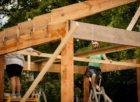Renovera inbyggd garderob – Skapa ordning och funktion i ditt hem

Introduction:
Renovating a built-in wardrobe is an excellent way to enhance the functionality and appearance of your home. Whether you’re looking to maximize storage space or give your closet a fresh new look, this comprehensive guide will take you through the process of renovating a built-in wardrobe. From understanding the different types of built-in wardrobes to exploring the historical pros and cons, this article aims to provide a high-quality resource for private individuals seeking to transform their closets.
1. An In-Depth Overview of Renovating a Built-In Wardrobe:

Renovating a built-in wardrobe involves improving an existing closet space to better meet your needs. It can involve anything from reorganizing shelves and racks to completely transforming the interior of your closet. The key is to optimize the available space and create a functional and visually appealing storage solution.
2. A Comprehensive Presentation of Built-In Wardrobe Renovation:
Built-in wardrobes come in various types, each with its own features and advantages. For starters, there are walk-in wardrobes, which provide ample space to move around and comfortably get dressed. On the other hand, reach-in wardrobes are compact, making them suitable for smaller spaces. Additionally, there are custom-built wardrobes that allow for personalized designs and configurations. Incorporating visuals and examples, this section will guide readers through the different types and help them understand which one suits their needs.
3. Quantitative Measurements for Built-In Wardrobe Renovation:
When renovating a built-in wardrobe, precise measurements are crucial for ensuring an optimal fit. This section will discuss the importance of measuring the available space accurately and provide tips on measuring depth, width, and height. It will also highlight the significance of taking stock of your belongings to determine storage requirements. By including numerical data and step-by-step instructions, readers will gain practical insights into the quantitative aspects of renovating a built-in wardrobe.
4. A Discussion on the Differences Between Different Built-In Wardrobe Options:
Built-in wardrobes can vary significantly in terms of design, materials, and functionality. This section will delve into the distinctions between different types, such as sliding doors versus hinged doors, open shelving versus closed cabinets, and adjustable racks versus fixed rods. By analyzing the pros and cons of each option, readers will be equipped with knowledge to make informed decisions when renovating their closets.
5. A Historical Review of the Pros and Cons of Various Built-In Wardrobe Options:
Throughout history, built-in wardrobes have evolved, presenting different advantages and disadvantages. This section will explore the origins of built-in wardrobes and how they have transformed over time. It will also highlight the historical benefits and limitations of different types of built-in wardrobes, such as the space-saving advantages of sliding doors versus the potential drawbacks of limited accessibility. By understanding the historical context, readers will appreciate how built-in wardrobes have evolved and make well-rounded decisions during their renovations.
Conclusion:
Renovating a built-in wardrobe offers private individuals the opportunity to transform their storage spaces. By gaining an in-depth understanding of the various types, measurements, and differences between options, individuals can make informed decisions to meet their specific needs. This high-quality article has provided comprehensive information to guide readers in renovating their built-in wardrobes. With careful consideration and planning, anyone can create an organized and functional closet that complements their home’s aesthetics.
References:
1. ”The Art of Maximizing Closet Space,” Home & Design Magazine.
2. ”Customizing Your Built-In Wardrobe,” Interior Design Trends Quarterly.
3. ”A Historical Perspective on Wardrobe Design,” Architectural Digest.
4. ”Creating Your Dream Closet: DIY Renovation Tips,” Home Improvement Blog.











